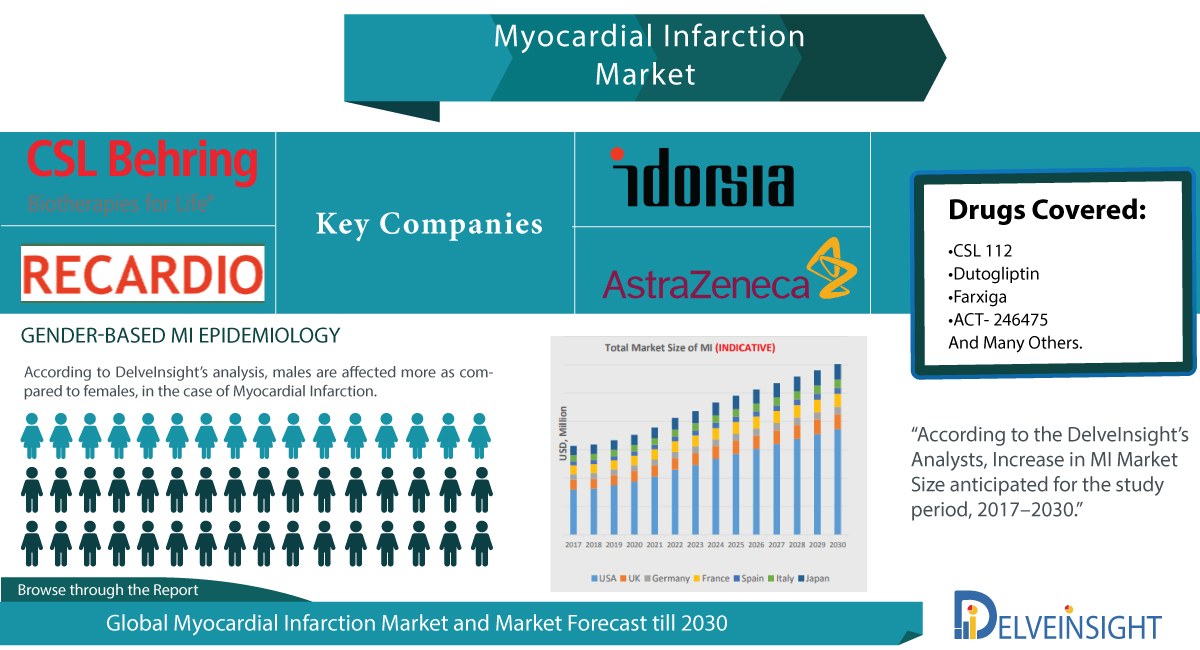(Albany, US) DelveInsight has launched a new report on Myocardial Infarction Epidemiology Forecast -2030.
Some of the key facts of the Report:
- Myocardial infarction retains a substantial footprint on global health, affecting more than 7 million individuals worldwide each year and
- Myocardial infarction leads to more than 4 million deaths in Europe and northern Asia.
- Every 40 seconds, someone in the United States has a heart attack.
Myocardial Infarction, commonly known as heart attack occurs when blood flow declines or stops to a part of the heart, triggering damage to the heart muscle. The risk of myocardial infarction increases with age. The other causes could be smoking, high blood pressure, diabetes mellitus or high levels of cholesterol. Enormous consumption of polyunsaturated fats can also lead to heart attacks.
Symptoms associated with Myocardial Infarction include chest pain that may appear as a sensation of tightness or pressure initially. Pain radiates most often to the left arm, but may also radiate to the lower jaw, neck, right arm, back, and upper abdomen. Chest pain may be accompanied by sweating, nausea or vomiting, and fainting.
Acute Myocardial Infarction is an event of myocardial necrosis caused by an unstable ischemic syndrome. The condition is reported as a common cardiac emergency, prone to substantial morbidity and mortality. The disease occurrence in the absence of critical epicardial coronary disease is increasingly observed.
“According to DelveInsight’s analysis, males are affected more as compared to females, in the case of Myocardial Infarction.”

- The Myocardial Infarction report covers a detailed overview explaining its causes, symptoms, classification, pathophysiology, diagnosis and treatment patterns
- The Myocardial Infarction Epidemiology Report and Model provide an overview of the risk factors and global trends of Myocardial Infarction in the seven major markets (7MM:US, France, Germany, Italy, Spain, UK, and Japan)
- The report provides insight about the historical and forecasted patient pool of Myocardial Infarction in seven major markets covering the United States, EU5 (Germany, Spain, France, Italy, UK), and Japan
- The report helps to recognize the growth opportunities in the 7MM with respect to the patient population
- The report assesses the disease risk and burden and highlights the unmet needs of Myocardial Infarction
- The report provides the segmentation of the Myocardial Infarction epidemiology
- 11-Year Forecast of Myocardial Infarction epidemiology
- 7MM Coverage
- Total Cases of Myocardial Infarction
- Total Cases of Myocardial Infarction according to segmentation
- Diagnosed cases of Myocardial Infarction
We interview, KOLs and SME’s opinion through primary research to fill the data gaps and validate our secondary research. The opinion helps to understand the total patient population and current treatment pattern. This will support the clients in potential upcoming novel treatment by identifying the overall scenario of the indications.
- What will be the growth opportunities in the 7MM with respect to the patient population pertaining to Myocardial Infarction?
- What are the key findings pertaining to the Myocardial Infarction epidemiology across 7MM and which country will have the highest number of patients during the forecast period (2017-2030)?
- What would be the total number of patients of Myocardial Infarction across the 7MM during the forecast period (2017-2030)?
- Among the EU5 countries, which country will have the highest number of patients during the forecast period (2017-2030)?
- At what CAGR the patient population is expected to grow in 7MM during the forecast period (2017-2030)?
- What is the disease risk, burden and unmet needs of the Myocardial Infarction?
- What are the currently available treatments of Myocardial Infarction?
- The Myocardial Infarction Epidemiology report will allow the user to –
- Develop business strategies by understanding the trends shaping and driving the global Myocardial Infarction market
- Quantify patient populations in the global Myocardial Infarction market to improve product design, pricing, and launch plans
- Organize sales and marketing efforts by identifying the age groups and sex that present the best opportunities for Myocardial Infarction therapeutics in each of the markets covered
- Understand the magnitude of Myocardial Infarction population by its epidemiology
- The Myocardial Infarction Epidemiology Model developed by DelveInsight is easy to navigate, interactive with dashboards, and epidemiology based with transparent and consistent methodologies. Moreover, the model supports data presented in the report and showcases disease trends over 11-year forecast period using reputable sources
- Patient Segmentation
- Disease Risk and Burden
- Risk of disease by the segmentation
- Factors driving growth in a specific patient population
1. Key Insights
2. Executive Summary of Metabolic Acidosis
3. Metabolic Acidosis: Disease Background and Overview
3.1. Introduction
3.2. Sign and Symptoms
3.3. Pathophysiology
3.4. Risk Factors
3.5. Diagnosis
4. Patient Journey
5. Epidemiology and Patient Population
5.1. Epidemiology Key Findings
5.2. Assumptions and Rationale: 7MM
5.3. Epidemiology Scenario: 7MM
5.3.1. Metabolic Acidosis Epidemiology Scenario in the 7MM (2017- 2030)
5.4. United States Epidemiology
5.4.1. Metabolic Acidosis Epidemiology Scenario in the United States (2017- 2030)
5.5. EU-5 Country-wise Epidemiology
5.5.1. Germany Epidemiology
5.5.1.1. Metabolic Acidosis Epidemiology Scenario in Germany (2017- 2030)
5.5.2. France Epidemiology
5.5.2.1. Metabolic Acidosis Epidemiology Scenario in France (2017- 2030)
5.5.3. Italy Epidemiology
5.5.3.1. Metabolic Acidosis Epidemiology Scenario in Italy (2017- 2030)
5.5.4. Spain Epidemiology
5.5.4.1. Metabolic Acidosis Epidemiology Scenario in Spain (2017- 2030)
5.5.5. United Kingdom Epidemiology
5.5.5.1. Metabolic Acidosis Epidemiology Scenario in the United Kingdom (2017-2030)
5.6. Japan Epidemiology
5.6.1. Metabolic Acidosis Epidemiology Scenario in Japan (2017- 2030)
6. Treatment Algorithm, Current Treatment, and Medical Practices
6.1. Metabolic Acidosis Treatment and Management
6.2. Metabolic Acidosis Treatment Algorithm
7. KOL Views
8. Unmet Needs
9. Appendix
9.1. Bibliography
9.2. Report Methodology
10. DelveInsight Capabilities
11. Disclaimer
12. About DelveInsight
Related Reports:
Myocardial Infarction – Pipeline Insights – 2020
Myocardial Infarction – Market Insights, Epidemiology and Market Forecast – 2030



